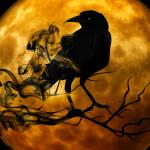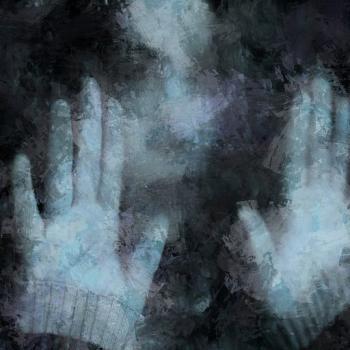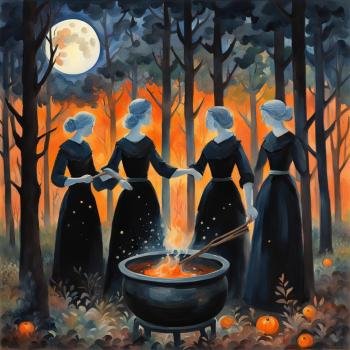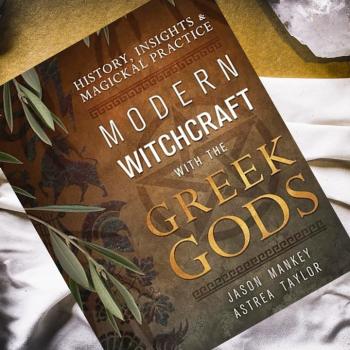So I may have mentioned before that I have some unconventional approaches to modern witchcraft. I don’t believe in Westernized instant-Karma, I don’t believe in the threefold law or the Wiccan Rede, I don’t believe in the veil between worlds. I also, often, don’t bother with that nearly ubiquitous practice of casting a formal circle aka compass*. I’m not actually disputing the usefulness of such a practice, but it’s not something I find I have much need for most of the time. My own type of witchcraft, which I call Fairy Witchcraft, has a different approach to circles than most in that it’s more casual and less essential. We don’t use circles at all rituals and when we do the purpose dictates the circle used, so a protective circle isn’t the same as one that might be cast for a ritual.

Modern Circles
My understanding is that circles in ceremonial magic were used to protect the magician from whatever they were summoning. In modern neopagan witchcraft the most common explanation I’ve seen for their use is to contain energy that’s raised, and secondarily to protect those within from outside forces. There’re many ways to create these barriers, but the basic approach is to face each cardinal direction, one at a time, and invoke the spirit of that direction then walk the boundary of your circle visualizing an energetic barrier forming. For traditional witches casting a compass is done differently, although the general concept is still the same, and the purpose is to separate the space from the mundane. A good explanation of the process and purpose can be found at Kelden’s Introduction to the Witches’ Compass.
All of these are good practices within their respective traditions or spiritualities which is why they exist as traditions. When I started out in witchcraft I believed they were more than just good, I thought they were essential. But I started to realize that most of the time there just wasn’t any need to go to the trouble to cast a full circle/compass. It was tradition for the sake of tradition rather than for a real purpose.
Moving In Circles
There is a lot of evidence of circles in folklore and early modern witchcraft, but probably not what you’re imagining. If we’re not looking at the ceremonial material – arguably often the work of the elite rather than the common practitioner – we don’t find complex rituals or exotic ingredients. What we do find in most cases is simply walking in a specific direction to circle an area for a purpose. In Ireland and Scotland there’s evidence of movement deiseal [clockwise] done for blessing, usually three times, and movement tuathail [counterclockwise] done for malediction. Moving in a circle might be done to take an oath, break a spell, or cast enchantments or protective magics (Wimberly, 1928).
If we look at the ballad material we can find an example that might be closer to the idea of a witches’ circle, but again not the modern one. In some versions of the Ballad of Tam Lin the variously-named protagonist uses holy water to cast a compass around herself, apparently so that she will remain unseen by the Fairy Rade:
“There’s holy water in her hand,
She casts a compass round,
And presently a fairy band
Comes riding o’er the mound.” (Tam Lin 39D)

Generally the protagonist takes this action after being explicitly told to by her fairy lover:
“You’ll go down to Mile Course,
Between twelve o’clock and one,
And fill your hands with holy water,
And cast your compass round” (Tam-a-Line 39G, modified to English from original Scots)
In this case the circle of holy water acts as a protection for the woman from the fairies who are passing by and keep her hidden from their sight until she moves outside the circle’s bounds.
In modern witchcraft moving in a circle tuathail is often viewed as either connected to negative magic or to undoing something; for example some traditions go counterclockwise to take down a circle that’s been cast. In the older material while it is true that this direction of motion is associated with cursing it is also connected to Fairy. In the Ballad of Childe Rowland the protagonist’s sister is taken into Fairy after going around a church widdershins, with the implication that this action opened her up to fairy abduction; in the same way to gain entrance to rescue her the protagonist must walk three times round widdershins himself. In some of the Scottish witchcraft trial accounts the accused witches said they would turn or circle widdershins [counterclockwise] a certain number of times when seeing the new moon or meeting their patron (the Devil or the Queen of Fairy). Circling tuathail then is more nuanced than simply baneful magic, and I have found its very useful in my own practices.
My Circle Casting
My own approach is heavily influenced by early modern witchcraft and folk practices, which means the sources I look to include the ones I just discussed above. There’s no focus there on formal, multi-step circle casting – things are done by walking with intention or perhaps by sprinkling some holy water or milk** as you walk. The direction you walk in is important but each direction, with or against the sun, has its uses. I tend to see walking deiseal as blessing and walking tuathail as a means to connect to Fairy, although cursing is also a use for that movement. Sometimes my entire ritual might consist of nothing but moving with intention in a particular direction. You might be surprised how powerful walking or dancing in a particular direction while singing can be (or you won’t be surprised if you’ve done it before).

I write about an option in my book on Fairy Witchcraft to cast a more formal circle whose purpose, as in traditional witchcraft, is to separate the area from the rest of the world. Specifically the idea is to use the circle to open a pathway to Fairy, although I admit this isn’t something I often use formal ritual to do. I included it in the book to give people that framework if they need it, but for myself at this point I usually just stick with walking tuathail and chanting.
In formal ritual if I use a compass I cast it with clean water, blessed by me in the name of the Powers I serve. I sprinkle the water as I walk and I ask that that space be purified and be opened to the spirits I am working with. It’s not fancy and it’s not complicated but it’s effective. I only do this in situations with the sorts of Fairy beings who have higher standards for the spaces they occupy and who I wouldn’t invite into an area that wasn’t fit for them. In most smaller rituals or works of magic I don’t use compasses at all because they haven’t proved necessary.
Final Thoughts
In many areas of paganism and witchcraft some form of circle casting will be found as standard operating procedure for rituals, but often the reason why this is done every time didn’t make sense to me or didn’t make sense with what I was doing. I’ve never done well with practices I’ve been expected to do by rote without a solid understanding of why, and so I found that when I dug into why I was supposed to be casting a circle in ritual or magic most of the reasons didn’t gel with what I personally did. It wasn’t until I researched back and found the older types of circles that I found practices that resonated with me and which I understood intuitively. Then I shaped my own practice from there, with years of trial and error to figure out what did and didn’t work and what was and wasn’t essential.
Water and walking are as formal as I need to get, and it works just as well – better for me personally – than anything else I’ve ever tried.
*the concepts of casting a circle or casting a compass are effectively synonymous, and in fact the term ‘compas’ or ‘compasse’ in Scots means “a round or ring; a circle or circuit”. In practice they also seem to have many similarities, particularly the older versions.
**Wimberly discusses the possible connection between the holy water used in Tam Lin and milk, and given the significance of milk it makes sense to me to use that as a substance to make a boundary holy.
References
Carmichael, A., (1900) Carmina Gadelica volume I
Harold Johnson and the Cursing Stones (2011)
Wimberly, C., (1928) Folklore in the English and Scottish Ballads
McNeill, F., (1956) The Silver Bough
Child, F., (1882) The English and Scottish Popular Ballads

















